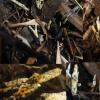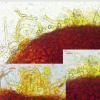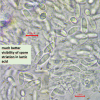
24-12-2025 17:08
Hulda Caroline HolteHello, I have found this propoloid ascomycete on

21-12-2025 09:32
Hello.A tiny ascomycete found embedded in wood in

21-12-2025 21:32
Pol DebaenstHello, Garden, Burgweg 19, Veurne, BelgiumOn 10/1

22-12-2025 23:38
Patrice TANCHAUDBonsoir, récolte sur un mur en pierre, apothéci

22-12-2025 00:47
Patrice TANCHAUDBonsoir, récolte à proximité du milieu dunaire
nectrioid fungus on Xylaria cinerea - anamorph and teleomorph belonging together?
Lothar Krieglsteiner,
17-12-2024 20:05
 in the Algarve, Serra Monchique, on old Xylaria cinerea on Acacia-logs near the ground in Eucalyptus-forest. First I noticed the yellowish color of the Xylaria and took a specimen. I show it first.
in the Algarve, Serra Monchique, on old Xylaria cinerea on Acacia-logs near the ground in Eucalyptus-forest. First I noticed the yellowish color of the Xylaria and took a specimen. I show it first.
Lothar Krieglsteiner,
17-12-2024 20:12

Re : nectrioid fungus on Xylaria cinerea - anamorph and teleomorph belonging together?
When looking more exactly I found older stromata of the Xylaria from the last year, quite strongly decayed and crumbly. On one of them I found some perithecia of a nectria-like fungus. I am not sure if it is perhaps the teleomorph belonging to the yellowish mould already showed.
The hairs of the "Nectria" are beautifully yellow and contrast well with the dark red perithecia. Unfortunately I found only few riep spores and no clear asci. The spores I measured 11-15/4-6. I am not really sure but perhaps the spores are longitudinally striate (as there were very few I am not sure if I am not talking about an optical artefact). The perithecia were mounted in KOH - and there was not decoloration, so no Nectriaceae. As the sample contains only of quite few ascomata I did not examine more perithecia by now.
Who does have an idea?
Yours, Lothar
The hairs of the "Nectria" are beautifully yellow and contrast well with the dark red perithecia. Unfortunately I found only few riep spores and no clear asci. The spores I measured 11-15/4-6. I am not really sure but perhaps the spores are longitudinally striate (as there were very few I am not sure if I am not talking about an optical artefact). The perithecia were mounted in KOH - and there was not decoloration, so no Nectriaceae. As the sample contains only of quite few ascomata I did not examine more perithecia by now.
Who does have an idea?
Yours, Lothar
Lothar Krieglsteiner,
11-03-2025 16:53

nectrioid fungus on Xylaria cinerea - second investigation of the teleomorph
I was a bit surprised that nobody answered to this post, as I found the specimen to be quite characteristic. Today I made new preparations and can add:
1. The perithecia show a clear discoloration to yellow (over orange) when mounted in lactic acid. As I already wrote, KOH does not lead to a discoloration.
2. This time I found a lot of spores, few also still being in (hardly visible) asci. The authentic spores are definitely longitudinally striate, and measure about 10,5-12,5/3,4-4,5 µm.
Maybe somebody can make a proposal at least for the family, maybe the genus?
Maybe an undescribed species? - as the substrate is quite special.
Best, Lothar
1. The perithecia show a clear discoloration to yellow (over orange) when mounted in lactic acid. As I already wrote, KOH does not lead to a discoloration.
2. This time I found a lot of spores, few also still being in (hardly visible) asci. The authentic spores are definitely longitudinally striate, and measure about 10,5-12,5/3,4-4,5 µm.
Maybe somebody can make a proposal at least for the family, maybe the genus?
Maybe an undescribed species? - as the substrate is quite special.
Best, Lothar
Andgelo Mombert,
11-03-2025 17:33

Re : nectrioid fungus on Xylaria cinerea - anamorph and teleomorph belonging together?
Hello,
I think it's a Sarcopodium, possibly a undescribed species close to S. flocculentum. Molecular data is needed !
Andgelo
I think it's a Sarcopodium, possibly a undescribed species close to S. flocculentum. Molecular data is needed !
Andgelo
Lothar Krieglsteiner,
11-03-2025 17:39

Re : nectrioid fungus on Xylaria cinerea - anamorph and teleomorph belonging together?
Hello Angelo,
thank you very much for your expertise! I just asked fot a publication on this species (S. flocculentum) on Researche Gate.
Do you have capactities to do the molecular work? In this case I would send you the specimen (or half of it - it is not very large).
Otherwise, I could (not immediately, but perhaps this year) send a piece to Pablo Alvarado for commercial sequencing. I plan to do this with some fungi (mainly basidiomycetes) anyway for this year.
But I must admit: I am not familiar with the work to be done with the sequence (alignment, and so on). I would need help with this.
Somebody interested?
Yours, Lothar
thank you very much for your expertise! I just asked fot a publication on this species (S. flocculentum) on Researche Gate.
Do you have capactities to do the molecular work? In this case I would send you the specimen (or half of it - it is not very large).
Otherwise, I could (not immediately, but perhaps this year) send a piece to Pablo Alvarado for commercial sequencing. I plan to do this with some fungi (mainly basidiomycetes) anyway for this year.
But I must admit: I am not familiar with the work to be done with the sequence (alignment, and so on). I would need help with this.
Somebody interested?
Yours, Lothar
Lothar Krieglsteiner,
11-03-2025 17:40

Re : nectrioid fungus on Xylaria cinerea - anamorph and teleomorph belonging together?
... and I forgot to ask: do you think the anamorph (first contribution on top of the page) belongs to the peculiar teleomorph?
Andgelo Mombert,
11-03-2025 21:38

Re : nectrioid fungus on Xylaria cinerea - anamorph and teleomorph belonging together?
No, i'm sorry :-(
Lothar Krieglsteiner,
11-03-2025 22:35

Re : nectrioid fungus on Xylaria cinerea - anamorph and teleomorph belonging together?
thank you for this, too!
Lothar Krieglsteiner,
12-03-2025 09:37

Re : nectrioid fungus on Xylaria cinerea - anamorph and teleomorph belonging together?
does perhaps somebody have this:
Lanatonectria flocculenta (Henn. & E. Nyman) Samuels & Rossman, in Rossman, Samuels, Rogerson & Lowen, Stud. Mycol. 42: 138 (1999)
and could send me a file?
Yours, Lothar
Lanatonectria flocculenta (Henn. & E. Nyman) Samuels & Rossman, in Rossman, Samuels, Rogerson & Lowen, Stud. Mycol. 42: 138 (1999)
and could send me a file?
Yours, Lothar
Gernot Friebes,
12-03-2025 13:10
Re : nectrioid fungus on Xylaria cinerea - anamorph and teleomorph belonging together?
Lieber Lothar,
gibt es hier: https://studiesinmycology.org/sim/Sim42/content/pdf/137-140.pdf
Schöne Grüße
Gernot
gibt es hier: https://studiesinmycology.org/sim/Sim42/content/pdf/137-140.pdf
Schöne Grüße
Gernot
Lothar Krieglsteiner,
12-03-2025 13:38

Re : nectrioid fungus on Xylaria cinerea - anamorph and teleomorph belonging together?
vielen Dank, Gernot!
I see there that flocculenta is quite similar but has spinulose hairs (my collection has not).
I see there that flocculenta is quite similar but has spinulose hairs (my collection has not).










